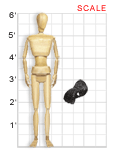From the collection of:
Frazier Historical Arms Museum || VAM Home
Filippo Negroli (Italian, c. 1510-1579)
RIGHT GAUNTLET, c. 1540
III.813
© The Board of Trustees of the Armouries
Courtesy of the Trustees of the Royal Armouries
A gauntlet is an armored glove used to protect the wrist, hand, and fingers. In times of hand-to-hand combat, gauntlets were crucial pieces of armor because those areas were particularly vulnerable. Gauntlet styles range from leather gloves and mail to jointed metal plates. Hammered from the inside with special tools to create the ornate relief design on the exterior, this gauntlet was not intended for use in actual combat, but was made to be worn ornamentally with fancy dress.
About the Artist
In the 16th century, armor was a symbol of the wealth, taste, and social standing of its wearer. Inspired by the forms and ornament of classical art, pieces were often embossed in high relief, richly gilded, and inlaid with gold and silver. Rival rulers competed to have the richest and most impressive armors possible.
Rising to this artistic challenge in greatest distinction were the armorers of northern Italy, who had been international leaders in the craft of armor from at least the 14th century. One of the leading crafters of parade armor was Filippo Negroli of Milan. His skills and imaginative designs earned him the patronage of French kings François I and Henry II, Holy Roman Emperor Charles V, and other prominent princes of the time.
Classroom Ideas
Discussion: How do you think it would feel to wear a gauntlet like this one? What would be some of the pros and cons of wearing it during battle? What happened to make gauntlets and other body armor obsolete? What are some reasons one might create or use armor, weapons, and/or uniforms for something other than battle? Can you think of examples of such items being used for purely ornamental purposes in modern times?
Activity: Design your own set of body armor. Think about how you would make it, what materials you would use, how you would put it on, and what it would look like.
Links
Read about arms and armor in Renaissance Europe on the Metropolitan Museum of Art’s timeline of art history. The site also includes an image of a burgonet by Filippo Negroli.
[www.metmuseum.org/toah/hd/rarm/hd_rarm.htm]
[www.metmuseum.org/toah/ho/08/eustn/hod_17.190.1720.htm]
The History and Art of Weapons, a guide to the Frazier Historical Arms Museum created by the Louisville Courier-Journal, includes background on the museum itself as well as the history of arms as works of art.
[www.courier-journal.com/cjextra/frazier/]
See more images of historic arms at the Frazier web site.
[www.frazierarmsmuseum.org/media/royal/royal.php]
You’ll find further explanations and photos of armor at the Destrier Tournamenter web site.
[www.destriertournamenter.wanadoo.co.uk/armour.html]
Find out more about Britain’s Royal Armouries and artifact preservation at the armouries web site.
[www.armouries.org.uk]




